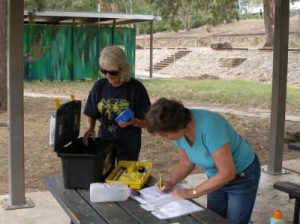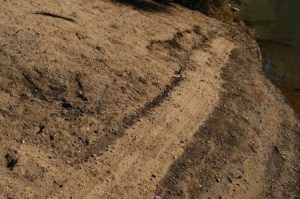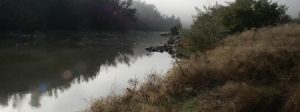SACTCG Waterwatch group profile

Wendy Rainbird and Anne I’Ons have an impressive history with the Canberra region and working for our environment. Anne is the Parkcare Coordinator of the Mount Taylor Parkcare group and Wendy is the Coordinator of the Farrer Ridge Parkcare group and between them they have over 40 years of active Landcare involvement. They form the ‘Sands’ Waterwatch team that have kept an eye on the recovery of the Murrumbidgee River since the inception of the C.A.M.P.F.I.R.E program initiated by ACT Waterwatch in the aftermath of the 2003 fires. Wendy recounts how the Southern ACT Catchment Group were approached at one of their meetings by Nigel Philpot, the then ACT Waterwatch Facilitator. ‘People were feeling pretty devastated. They put out the call for people to do river monitoring. Nigel explained how they would go as far up into the catchment as they could, into the source water and downstream right down the Murrumbidgee.’ Anne nudged Wendy and said ‘Why don’t we do this?’
They were trained soon after by Bayne Geikie (now of ActewAGL), who was also my coordinator when I was a school teacher doing Waterwatch with students during the late 90’s.
I asked why they chose Casuarina Sands and Wendy replied ‘We had no choice! We were allocated the site!’ Wendy added ‘We’ve come down each month monitoring the Murrumbidgee water at Casuarina Sands and we’ve been doing it for 7 years. It took 5 years for the river to begin to look as it did before the 2003 fires.’
Long before the fires Wendy and Anne both used to bring their children to swim at various locations along the river, so to see the river in such bad condition was heart breaking. Anne said ‘The whole landscape has changed along the Murrumbidgee since the 1960’s. The tall stands of Casuarinas and Eucalypts have disappeared and there is a greater abundance of woody weeds and exotic grasses, especially African lovegrass.’ After the fires the river was black with soot all along the bank. In fact the whole area around Casuarina Sands reserve was black. ‘The valleys on the opposite bank to the park were just devastated.’ Anne was still seeing black debris washed in along the river bank up until the end of last year. ‘There would be a black tide line of soot which would wash away then reappear’. Because the waterway broadens and the water slows along the river stretch near the reserve, soot had time to accumulate.

Coming down month after month after the fires, Wendy and Anne wondered which of the big Casuarinas would survive. Unfortunately, very few. They will take an estimated 50 to 100 years to return to their former glory. The eucalypts were the first trees to bounce back, with epicormic growth appearing well before any shoots on their crowns. ‘The wattles are about to come out and there is quite a lot of Xanthorrhoea sp.’ Anne also delights in saying that they have heard a lyre bird many times on the far bank. Their friend the local wombat has also withstood recent changes, choosing to make good use of the new structural works to house a fresh burrow. We are very proud!

If you are interested in finding out more about the ‘Sands’ Waterwatch group, or indeed any related activities please contact Martin Lind on 6296 6400, or email Waterwatch@sactcg.org.au.

